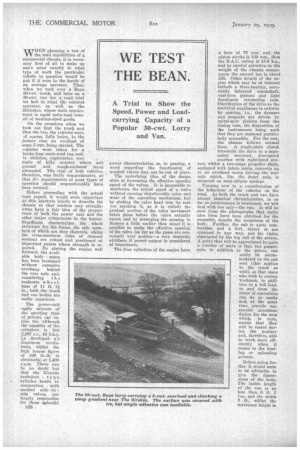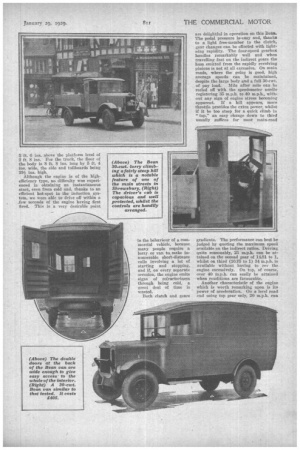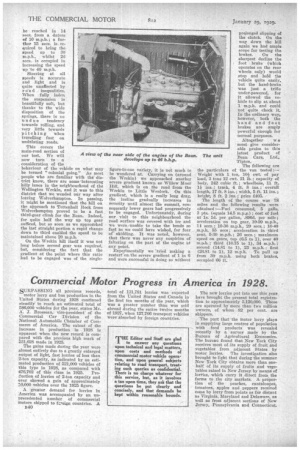WE TEST THE BEAN.
Page 22

Page 23

Page 24

If you've noticed an error in this article please click here to report it so we can fix it.
A Trial to Show the Speed, Power and Load-. carrying Capacity of a Popular 30-cwt. Lorry
WHEN planning a test of the road capabilities of a commercial chassis, it is neces
sary first of all to make up one's mind exactly to what type of work the particular vehicle in question would be put if it were in the hands of an average operator. Thus, when we took over a Bean 8O-cwt. truck, and later on a 30-cwt. van for a road trial we had in mind the colonial operator, as well as the Britisher, whose main requirement is rapid main-road transit of medium-sized goods.
On the occasions when we took out first the truck and -then the van, the vehiclenwere, of ceurse, fully laden, in the former case an overload of some 5 cwt. being carried. The vehicles were taken for a , fairly-Jong main-road run and, in addition, exploration was • made of hilly country . where soft ground and rough-surfaced lanes abounded. The trial ,of both vehicles, therefore, was fairly comprehensive, so that the. requirements of most types of operator should unquestionably have been covered.
Before. proceeding with the actual road report, it would seem opportune at this juncture briefly to describe the chassis so that readers may straightaway.have a fair idea of the proportions of both the power unit and the other major components in the layout. Sturdiness characteriges the whole structure for the frame, the side' members of which are deep channels, whilst the cross-members (also of channel section) are robust and positioned at important points where strength is required. By placing the engine well forward, the available body space has been increased without excessive overhang behind the rear axle and,
considering t h e moderate wheelbase of 11 ft. 14 in., both the truck and van bodies are really capacious.
The power-unit Nally savours of the sporting type of private car engine for, although the capacity of the cylinders is but 2,297 c.c., 46 b.h.p. is developed a t maximum revolutions, whilst the high torque figure of 100 ft-lb. is obtainable at 1,400 r.p.m. There can be no doubt but that the Ricardo turbulent type cylinder, heads, in conjunction . with masked side by side valves, are largely responsible for these splendid B38 power characteristics, so, in passing, a word regarding the functioning of masked valves may not be out of place.
The underlying idea of the design aims at increasing the effective opening speed of the valves. It is impossible to accelerate the initial speed of a valve without causing objectionable noise am] wear of the operating mechanism, but by sinking the valve head into its seat (or masking it, as it is called) the gradual portion of the valve movement takes place before the valve actually opens, and by arranging the opening to happen a little earlier than usual it is possible to make the effective opening of the valve (so far as the gases are concerned) very sudden—a very desirable attribute if power output is considered of importance.
The four cylinders of the engine have
a bore of 75 mm'. and the piston stroke is 130 mm., thus the R.A.C. rating is 13.9 h.p., and by cateful attention to the weight of the chassis components the annual tax is about £26. Other details of the engine which may be of interest include a three-bearing, accurately balanced crankshaft, east-iron pistoas. and light duralumin connecting rods. Distribution of the drive to the electrical auxiliaries is entirely by gearing, i.e., the dynamo and magneto are driven by spiral-spur rlitions from the timing case, the disposition of the instruments being such that they are rendered particularly accessible. For the rest, the chassis follows normal lines. A single-plate clutch transmits the drive to a separately mounted, four-speed gearbox with right-hand con
trol, whilst a two-stage propeller shaft, equipped with fabric joints, connects up to an overhead worm driving the rear axle which, like the front axle, is mounted on semi-elliptic springs.
Turning now to a consideration of the behaviour of the vehicles on the road. As both the truck and van have almost identical characteristics, in so far as _performance is concerned, we -will deal with one only—the van. It will be ,seen from the photographs that really nice lines have been obtained for the ensemble, despite the roominess of the body. Further, the cab is quite comfortable and a 6-ft. driver is not cramped in any way, nor his vision obstructed by the top rail of the screen. A point that will be appreciated by quite a •number of users is that two passengers, in addition to the driver, can easily be accommodated on the cab seat (this apPlies to the. truck as well), so that users who wish to convey workmen, it
addition to a full load, to and from the scene of operations can do so easily and, at the same time, provide reasonable accommo‘' dation for the men which, in turn, means that they will be rested during the journey and, therefore, able to work more efficiently when it comes to the loading or unloading process.
Before going farther it would seem to be advisable to give the dimensions of the body.. The inside length of the van is no less than. 9 ft. 3 ins., and the width 5 ft., whilst the maximum height is
5 ft. 6 ins. above the platform level of 2 ft. 8 ins. For the truck, the floor of the body is 8 ft. 8 ins, long by 5 ft. 4 ins, wide, the side and tailboards being 191 ins. high.
Although the engine is of the highefficiency type, no difficulty was experienced in obtaining an instantaneous start, even from cold and, thanks to an efficient hot-spot in the induction system, we were able to drive off within a ,few seconds of the engine having first fired. This is a very desirable point
are delightful in operation on this Bean. The pedal pressure is 'easy and, thanks to a. light free-member to the clutch, gear changes can be effected with lightning rapidity. The four-speed gearbox handles remarkably well and when travelling fast on the indirect gears the hum emitted from the rapidly revolving pinions is not at all excessive. On main roads, where the going is good, high average speeds can be maintained. despite the large body and a full 30-cwt. of pay load. Mile after mile can be reeled off with the speedometer needle registering 35 m.p.h. to 40 m.p.h., without any sign of engine stress becoming apparent. If a hill appears, more throttle provides the extra power, whilst if it be too steep for a quick climb in "top." an easy change down to third usually suffices for most main-road
gradients. The performance can best be judged by quoting the maximum speed available on the indirect ratios. Driving quite reasonably, 23 m.p.h. can be attained on the second gear of 11.81 to 1, whilst on third (10.75 to 1) 34 m.p.h. is available without having to rev the engine excessively. On top, of course, over 40 m.p.h. can easily be attained when conditions are favourable.
Another characteristic of the engine which is worth remarking upon is its power of acceleration. On a level road end using top gear only, 20 m.p.h. can be reached in 14 secs, from a datum of 10 m.p.h.; a further 15 secs, is required to bring the speed up to 30 m.p.h., whilst 26 secs. is occupied in increasing the speed lip to 40 m.p.h.
Steering at all epeeds is accurate and light and is quite unaffected by road inequalities. When fully laden the suspension is beautifully soft, but thanks to the wide disposition of the springs, there is no
undue tendency towards rolling, and very little towards pitching when travelling fast on undulating roads.
This covers the main-road section of our test. We will now turn to a consideration of the behaviour of the vehicle on what may be termed "colonial going." As most people who are familiar with the district know, there are some 'interesting hilly lanes in the neighbourhood of the Wellington Wrekin, and it was to this district that we wended our way after leaving Wolverhampton. In passing, it might be mentioned that the hill on the approach to Tettenhall Rock from Wolverhampton proved to be a fast third-gear climb for the Bean. Indeed, for quite half the way up top gear sufficed, but so soon as we approached the last straight portion a rapid change down to third enabled the speed to be maintained above 20 m.p.h.
On the Wrekin hill itself it was not long before second gear was required, but, considering the fact that the gradient at the point where this ratio bad to be engaged was of the single figure-to-one variety, it is not much to be wondered at. Carrying on (around the Wrekin) we approached another severe gradient known as Willow Moor Hill, which is on the road from the Wrekin to Little Wenloek. On this gradient, which is a really long drag, the incline gradually increases in severity until almost tlie summit, consequently lower gears had progressively to be engaged. Unfortunately, during our visit to this neighbourhood the road surface was covered with ice and we weresunable to take the bends so fast as we could have wished, for fear or skidding. It was noted, however, that there was never any suspicion of faltering on the part of the engine at any point.
Experimentally we 'tried making a restart on the severe gradient of 1 in 6 and were successful in doing so without prolonged slipping of the clutch. On the way down the hill again we had ample scope for testing the brakes. On the sharpest decline the
■ foot brake (which operates on the rear wheels only) would stop and hold the vehicle quite easily, but the hand-brake was just a trifle under-powered, for it allowed the vehicle to slip at about 1 m.p.h. and could not quite check it. In the ordinary ways however, both the hand and foot brakes are amply powerful enough tor normal purposes.
Altogether we must give considerable praise to this latest product of Bean Cars, Ltd., Tipton.
The following are the particulars of the van tested :Weight with 1. ton, 10i cwt. of pay load, 3 tons 12 cwt. 21 lb.; capacity of body, 242 cubic ft.; wheelbase, 11 ft. 14 ins.; track, 4 ft. 8 ins. ; overall length, 17 ft. 8 ins. ; width, 5 ft. 11 ins.; height, 8 ft. 2 ins. ; price £405. , The length of the course was 78 miles and the following results were obtained :—Puel consumed, 5 galls. 3 pts. (equals 14.5 m.p.g.) ; cost of fuel at 1s. 1d. per gallon, .896d. per mile; acceleration on top gear, 10-20 m.p.h., 11 sees.; • 10-30 m.p.h., 29 secs.; 10-40 m.p.h, 55 secs; acceleration in third gear, 5-30 m.p.h.; 26 sees.; • maximum apeed on gears, top (6.5 to 1), over 40 rn.p,h.; third (10.75 to 1), 34 m.p.h.; second (14.81 to 1), 23 m.p.h.; first (26.81 to 1), 12 m.p.h. To pull up from 30 m.p.h. using both brakes, occupied 66 ft.


































